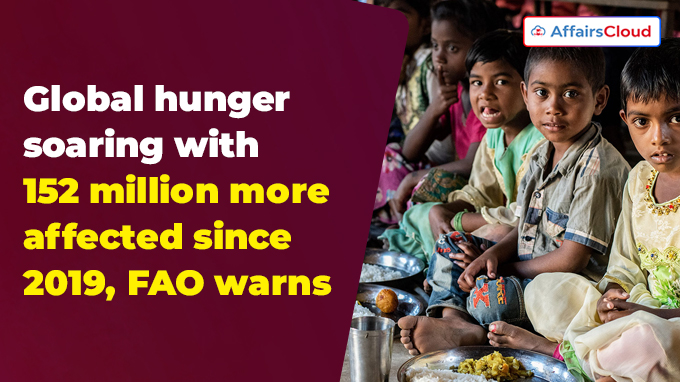 According to the Food and Agriculture Organisation (FAO)’s “World Food and Agriculture: Statistical Yearbook 2024”, despite rising food production, global hunger continues to worsen, with 152 million more people facing hunger in 2023 compared to pre-pandemic levels in 2019.
According to the Food and Agriculture Organisation (FAO)’s “World Food and Agriculture: Statistical Yearbook 2024”, despite rising food production, global hunger continues to worsen, with 152 million more people facing hunger in 2023 compared to pre-pandemic levels in 2019.
- This report was released at the 5th United Nations World Data Forum(UNWDF 2024) held in Medellín, Colombia from November 12–15, 2024.
- This latest edition of FAO’s yearbook is structured into 4 thematic chapters covering: the economic dimensions of agriculture; the production; trade; and prices of commodities; food security and nutrition; and sustainability and environmental aspects of agriculture.
Key Findings:
i.As per the report, hunger affected 9.1% of the global population in 2023, which is more than the 7.5% estimated for 2019.
- This alarming trend indicates towards the rising challenge of achieving the United Nations (UN) mandated Sustainable Development Goal (SDG) 2 of Zero Hunger by 2030.
ii.Over the last two decades, global agricultural value has increased by 89% in real terms, reaching USD 3.8 trillion in 2022.
- Agriculture’s contribution to the global Gross Domestic Product(GDP) has remained stable at around 4% since 2000.
- The report noted that despite this growth, the contribution of the agriculture sector to the global economic output has remained relatively stable, and the share of the global workforce employed in agriculture has declined, from 40% (in 2000) to 26% (in 2022).
- The countries with the largest agriculture, forestry and fishing sector in terms of value added in 2022 are China, India and the United States of America(USA).
iii.The report highlighted rising obesity rates, particularly in high-income regions. It showed that more than 25% of adults in the Americas, Europe and Oceania are obese, reflecting the global challenge of ensuring access to healthy, nutritious food.
iv.The report noted that the global level of Prevalence of Undernourishment (PoU), which had increased significantly in 2020 and more slowly in 2021, persisted at nearly same level from 2021 to 2023.
- As per the report, Africa region has the highest PoU, followed by Asia region.
v.In 2023, between 713 and 757 million people were undernourished. The report highlighted that even though the number of people facing hunger in Asia decreased by 2 million between 2022 and 2023, it still increased to 385 million between 2019 and 2023.
- Also, the Asia region accounted for 52% of the global undernourished people, and one of the main reasons being its large population base.
Global Food Production:
i.As per the report, the global production of primary crops reached 9.6 billion tonnes in 2022, up by 56% compared to 2000. Staple crops like sugarcane, maize, wheat and rice together accounted for approximately 50% of global crop production.
ii.Meat production surged by 55% from 2000 to 2022, with chicken constituting for the share of this rise. Globally, 361 million tonnes of meat were produced in 2022, with chicken surpassing pork as the produced meat.
- These trends indicated that the reason behind hunger or persistent food insecurity was not a problem of production but a problem of access, affordability and prevailing inequality.
iii.The report showed that the use of pesticides has increased significantly by 70% between 2000 and 2022, with America’s alone constituting for 50% of the global pesticide use in 2022.
- Also, the usage of inorganic fertilizers in agriculture has increased by 37% compared with 2000, reaching 185 million tonnes in 2022.
- Nitrogen (N) accounted for 58% of inorganic fertilizers used in agriculture in 2022.
iv.The report revealed that globally, the production of vegetable oils increased by 133% between 2000 and 2021, mainly attributed to an increase in palm oil production.
v.As per the report, Greenhouse gas emissions from agrifood systems have increased by 10% between 2000 and 2022, Farm-gate emissions increased by 15% during the same period, with the livestock sector contributing to nearly 54% of these emissions.
vi.The report highlighted that water scarcity remains a growing concern in regions like: the Near East and North Africa, where many countries are facing extreme water stress, affecting the sustainability of agricultural production.
- Countries like: Kuwait, the United Arab Emirates (UAE) and Saudi Arabia are withdrawing annually 9 to almost 40 times their renewable freshwater resources available.
About Food and Agriculture Organisation (FAO):
It is of the specialized agencies of the United Nations (UN), to make international efforts to combat hunger and to achieve food security for all.
Director-General (DG)- Qu Dongyu
Headquarters- Rome, Italy
Established- 1945




